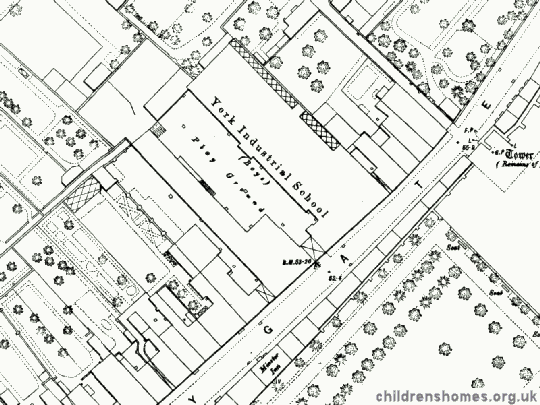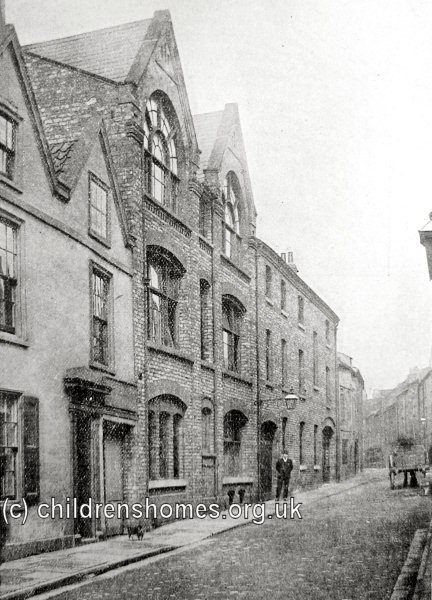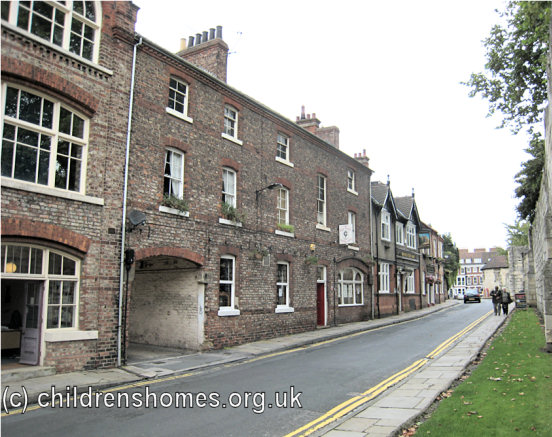York Ragged and Industrial Schools, Marygate, York, East Riding of Yorkshire
The York Ragged Schools were opened in February, 1848, largely due to the efforts of Mr. J.W. Locking. They provided elementary education, industrial training and food for necessitous children in the city. Some residential accommodation was also available for children who were destitute and homeless. The Schools initially occupied small premises in College Street, York. In its first year of operation, the average attendance of children was 62, varying from five to eleven years of age.
The establishment viewed its object as not so much train the children to any particular branch of trade, to inculcate in them the habits of industry and prepare for future life either as workmen or domestic servants. The younger boys were engaged in oakum picking, net-making, and knitting; the older ones in tailoring, shoemaking, clog-making and cobbling. The latter were under the superintendence of workmen hired for the purpose, the tailor being employed for two days a week, and the shoemaker for three. The girls, under the direction of a ladies' committee, were taught sewing, knitting, etc., and the older ones, in rotation, assisted in the kitchen and were trained in every domestic employment. The children were occasionally employed in gardening, made possible by the owners of a plot of building land loaning it to the Schools' committee for that purpose. The three meals a day were provided for the scholars, at a cost of three half-pence per child. A savings' bank was also established, and the children encouraged to allow their money to remain until there was sufficient to purchase some useful article of clothing. The Schools appointed Thomas Snow as Visiting Assistant, to call on the parents of the children in their own houses, "for the purpose of inquiring into their capability of maintaining their children, impressing them with the necessity of cultivating habits of temperance, sanitary improvement, and strict morality."
In September, 1849, the committee purchased the old York workhouse on Marygate for the sum of £555. After some adaptation work had taken place, the Marygate premises consisted of separate boys' and girls' school rooms, each with their own yard; a class room and a boys' workshop; two washing and changing rooms, with a bath room attached; a kitchen and wash house; bedrooms for the children lodged in the institution; and apartments for the master and mistress. A stove room, for fumigating the children's clothes, was also erected. Part of the property, not immediately required by the Schools, was let for use as a Model Lodging House.
On July 18th, 1858, the establishment was certified as an Industrial School, allowing it to receive boys placed under detention by the courts. It could accommodate up to 120 boys and girls.
An inspection report in 1862 noted that the School premises had been enlarged by taking back the portion that had been used as a Model Lodging House. This addition provided good dormitories and day rooms. The boys were employed in shoemaking, carpentering, and wood-cutting, while the girls were engaged in needlework. The superintendent, Mr Moger, who was said to have been responsible for much of the recent improvement in the School, was leaving because of his differences with the committee. His successor, Mr. Stubbs, apparently did not prove equal to the requirements of the institution and was soon succeeded by Mr West, previously master of the Havannah Industrial School Ship at Cardiff, with his wife as matron. Mr Roberts was the schoolmaster, with his wife employed as a non-resident schoolmistress, and his sister taking charge of the children for the evening. The average number attending the School in 1863 was recorded as 60 boys and 20 girls, of whom 37 boys and 8 girls were under detention.
Following the death of Mrs Roberts in May, 1865, Miss Temple was appointed as schoolmistress. Under Mr West's encouragement, the children had saved up more than £5 for clothing, and had deposited over £4 in the savings bank. The Roman Catholic children at the School attended their own worship on Sundays, and receive religious instruction from a priest of their own faith.
It was reported in 1866 that the making of lucifer match boxes had been added to the boys' industrial occupations. An examination of the girls' school found that more than half could now read, and about a third could write fairly on slates or in copies, and showed a fair knowledge of basic arithmetic. In the boys' school, almost all of the 64 present could read fairly and do basic arithmetic.
New workshops were erected in 1867 in the yard adjoining the girls' playground, the former workshops being used for sawing and chopping wood, and the wood shop made into a washroom. The following year, a house for the superintendent was built at the entrance to the institution. Despite this attraction, Mr West decided to resign from his post so that he could study at St Bee's College with a view to taking up holy orders. He was succeeded in January, 1869, by Mr George Henry Hirst who had considerable experience in the management of a voluntary school of the same class, with Mrs Hirst as matron. On August 20th, 1869, there were 90 boys and 30 girls under detention at the School, plus a small number of day scholars. An inspection report on that occasion found that the domestic and other arrangements were inadequate for such a large a number of children. The main premises were said to be old and in bad repair, and very unsuitable for the requirements of a large establishment. The general appearance of the boys was far from satisfactory — they were both ragged and slovenly, and many of them were suffering from a variety of ophthalmia.
In response to these criticisms, some improvements were evident at the time of the 1870 inspection. A good laundry and ironing-room had been erected in the girls' yard, and the bedding was in better order. However, the building was still judged to be very unsuitable for the work to be carried on. The schoolmaster was now Mr Probert.
The Hirsts departed in September, 1871, and were replaced by Mr and Mrs W. Smith, formerly at the Middlesex Industrial School for Boys at Feltham. There was also a change in the teaching staff, with Mr Humphries as non-resident schoolmaster and Miss Humphries as schoolmistress.
In 1872, the School's management decided to completely rebuild the existing premises and to transfer the girls' department elsewhere. Rasing the required funds took several years to several years to accomplish however.
The 1874 inspection recorded 90 boys and 47 girls in attendance, of whom four boys and eight girls were voluntary cases. There was an irregular attendance of 15 to 20 day scholars. The boys' industrial occupation comprised a little tailoring and shoemaking, with a few engaged in gardening. The majority, however, were employed at wood-chopping. Several went out as house boys and errand boys. The girls did the washing, cooking, and housework. The system of permitting many of the older boys to deliver firewood in the city and to act as house boys in the neighbourhood was criticised as having being taken too far. Most seriously, though, the inspection found that the old buildings on the boys' side were in an exceedingly dangerous condition and were beyond repair, the timbers being in a very rotten state. The School's managers were informed that it was no longer safe to keep a number of children on the premises. With the threat of the School being closed, the committee decided to use the girls' schoolroom in the opposite wing of the building as a boys' dormitory, and to remove the girls elsewhere. An arrangement was rapidly made with the Girls' Industrial School at Leeds and the 35 girls then in residence were transferred there shortly afterwards.
During the reconstruction of the Marygate premises, the boys were lodged for a period in workshops and in the old building formerly occupied by the girls, which was also used for a schoolroom and dining-room. The corner-stone of the new premises was laid by the Lord Mayor of York, Mr Alderman Terry, on September 14th, 1875. The official re-opening was performed by the High Sheriff, Major Stapylton, taking on July 18th, 1876. The shape of the site did not allow the School's main frontage to be on Marygate, but it instead faced onto an internal courtyard. In fact, the entrance from Marygate was not materially altered. The new buildings, designed by Messrs. Atkinson, of Micklegate, were described in contemporary report:
The School site is shown on the 1891 map below.

York Industrial School for Boys site, York, c.1891.

York Industrial School for Boys, York, c.1900. © Peter Higginbotham

York Industrial School for Boys, York, c.1900. © Peter Higginbotham
In 1878, a joiner's and turner's workshop was established and a wood-turner employed to train the boys in its use. A year later, there were 8 boys learning tailoring, 12 shoemakers, and 8 turners. Many of the other boys were employed in the town assisting in gardens or houses. The 1879 report noted that the managers found so much trouble in dealing with the very young children sent to them, many of whom were delicate, that they had resolved for the future to accept no boys under 10 years of age. The schoolmaster was now Mr Hulse.
In 1880-1881, some adjoining premises were bought and the ground built on, A new show-room was added to display the items produced by the boys, together with rooms for the schoolmaster, and a recreation room. There was now a good string band, a brass band, and a drum and fife band, all taught by Mr Hulse. Sailor's dress had now been adopted for the boys, a change which the inspector found to be "not a very suitable or useful alteration." A mark system was in operation whereby good conduct resulted in small money rewards of 1d. to 4d. a week. Half of their awards were given to the boys to spend, and half was put into the bank for them. A number of prizes were also given for work and conduct.
Miss Milner, a lady who took great interest in the school, started a botany class, frequently taking the members out for botanical walks in the neighbourhood. A collection of dried flowers, some of them rare ones, was made by the boys. Miss Milner also took boys about to be discharged, into her house to teach them what would be expected from them in domestic service.
The wood-turning workshop, fitted with three double lathes and an endless band saw, became the principal industrial feature of the School. The work produced by the boys was displayed in the large show-room. When the Prince of Wales visited York in 1883, he chose and bought a bat made at the School. Discharged boys who had been taught turning could command from 10s. to 15s. a week on leaving the School, rising to 30s. a week in a short time. By 1885, Mr Archey had become schoolmaster and taught the boys freehand drawing. The senior classes were now learning geography.
In January, 1889, the Smiths departed and were replaced as superintendent and matron by Mr and Mrs George Busby. A number of small improvements had been made to the premises including an enlargement of the schoolroom and dining-room, and the repair of the drains, which had been in a bad state. An organ was presented to the School. Not for the first time, the School's annual inspection criticised the playground as being far too small for the 120 or so inmates. In 1892, a partial remedy was found by obtaining a two-acre play-field about a quarter of a mile from the School. All the boys were taken for a week's holiday in Scarborough and were put up in the disused borough gaol. The School's wood-chopping machine could turn out 8,000 bundles of firewood a day.
In 1893, the schoolmaster, Mr Archey, departed to New Zealand and was succeeded by Mr F. Phillips. The assistant teacher was now Mr Shaw. The superintendent had a very bad attack of typhoid fever, which was attributed to the effect of the bad neighbourhood.
Criticism of the School's situation was reiterated in the 1896 inspection report, with a suggestion that some of the private property that hemmed in the premises might be acquired to provided more space. A new laundry had been constructed, and the inside walls of one of the dormitories plastered — the others will still rough brickwork whitewashed over. In the schoolroom, most of the classes were given a rating of 'very fair' for composition, recitation, mental arithmetic, and geography, The sol-fa system had been introduced for singing, and there were said to be some good voices. Object lessons had been given to the juniors. It was recommended that drawing be introduced in conjunction with manual instruction. The allocation of boys to the various industrial occupations was: 12 wood-turners, 12 joiners, 12 shoemakers, 12 tailors, and 6 bakers who produced the School's bread requirements. Wood-chopping permanently employed about 20 boys, and others at odd times or when the weather was bad. About 35 boys went out to private houses or shops for two hours in the morning and had other work in the School. The turning department produced good work for the furniture and athletic trades. The tailor's shop only did institutional work but the boys did well on leaving. The shoe shop did institutional work for boys' and girls' schools, but the appliances were old-fashioned, and the after results were practically nil. The boys were given sessions of military and extension motions. There was no swimming both on the premises but in the summer the boys were taken to the Yearsley bath, a mile away. About 25 per cent of them could swim. Walks were taken out of the town two or three times a week. The boys went to nearly every entertainment in the town, and concerts and lantern entertainments were arranged nearly once a week in the winter. The school library contained books, but the boys seemed to prefer the illustrated magazines, of which there was a good supply.
A small swimming bath (14ft. 3in. by 12ft. 8in. and 5ft. deep) was constructed in 1899. In February of that year, Mr Robertson became schoolmaster. He in turn was succeeded by Mr Arthur B. Brown on 1st April, 1901. In April, 1900, Mr. R.G.C. Busby was appointed assistant schoolmaster.
In 1904, the recreation room was fitted up as a gymnasium. Gymnastics became a prominent part of the physical training activities, with all the boys receiving instruction.
In 1906, boys from the School won the first three prizes in an open competition organised by the Turners' Company in London. The shoemaker's workshop, which had not been very successful in placing boys out, was now given up except for repair work.
The staff in 1911 comprised the superintendent and matron, Mr and Mrs Busby; schoolmaster and schoolmistress, Mr and Mrs A.B. Brown; bandmaster, labour master and drill instructor, turner, joiner, tailor, shoemaker, cook, seamstress, labour mistress, laundress. Mr W. Hopton was appointed as the School's dentist. There were now 119 boys in the School, with 24 out on licence. Of the 78 inmates aged 13 or over, 64 were regularly employed in skilled occupations, including 20 in the band. Of 27 boys who left during the preceding year, 21 had gone to skilled or progressive occupations; all but three of these places were found by the School.
By 1915, Mr W. Dyke Meck had taken over as superintendent and was still in post in 1920.
On 13th October, 1920, it was announced that the School had resigned its certificate. It closed not long afterwards, with the boys then in residence being transferred to other institutions or licensed out.
The building was subsequently used as an elementary school and later became a Post Office employees' social club.
Records
Note: many repositories impose a closure period of up to 100 years for records identifying individuals. Before travelling a long distance, always check that the records you want to consult will be available.
- None identfied at present — any information welcome.
Census
Bibliography
- Higginbotham, Peter Children's Homes: A History of Institutional Care for Britain's Young (2017, Pen & Sword)
- Mahood, Linda Policing Gender, Class and Family: Britain, 1850-1940 (1995, Univeristy of Alberta Press)
- Prahms, Wendy Newcastle Ragged and Industrial School (2006, The History Press)
Links
- None noted at present.
Except where indicated, this page () © Peter Higginbotham. Contents may not be reproduced without permission.


